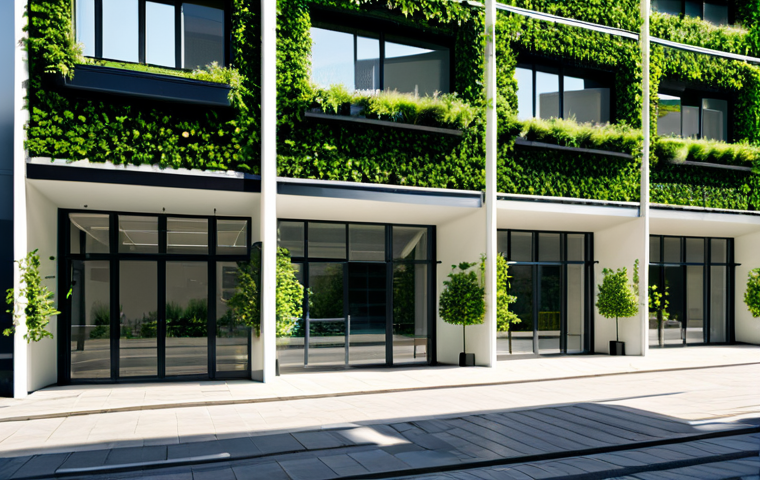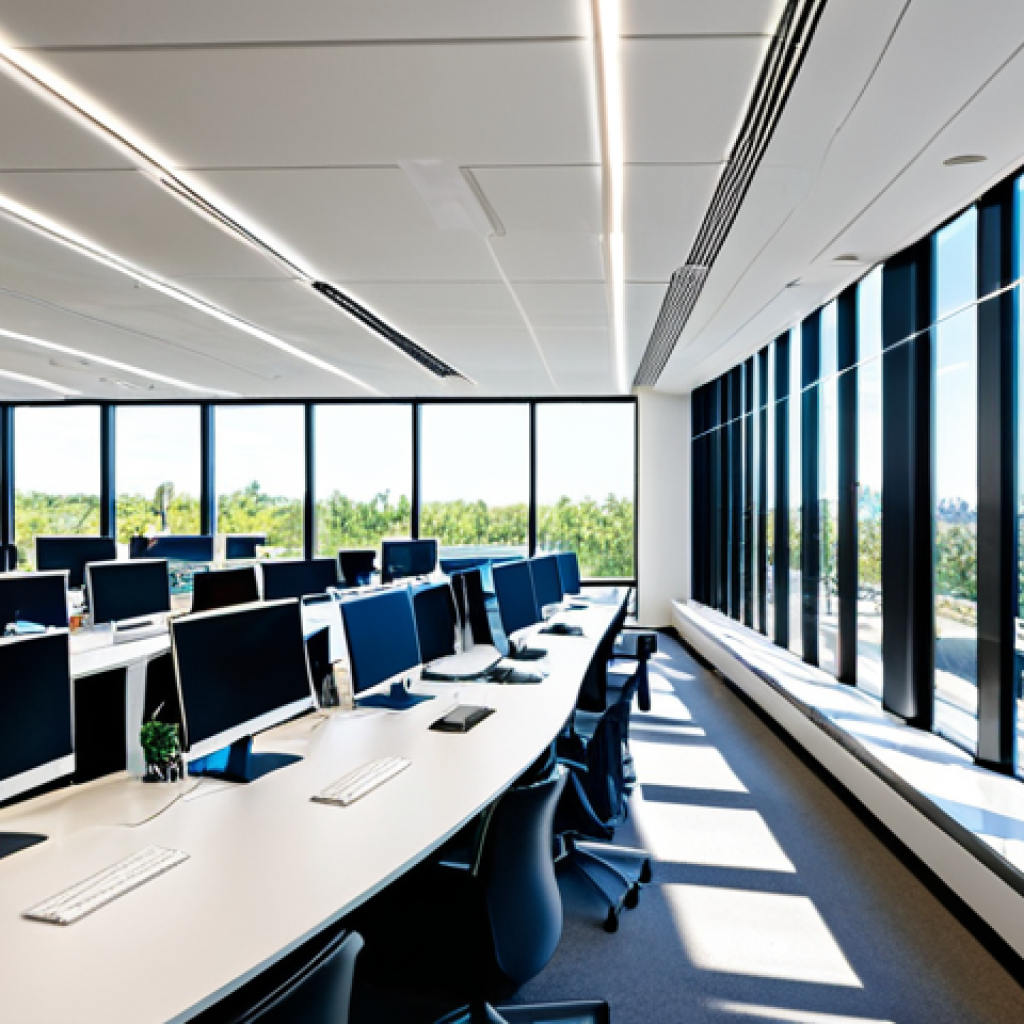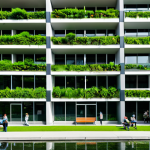Imagine walking into a building where the windows anticipate your needs. They tint automatically on a scorching summer day, preserving the energy and your comfort.
They open slightly to capture a gentle breeze, optimizing natural ventilation. Smart window technology is changing how we experience our living and working environments, and it’s not just about convenience.
It’s about sustainability, energy efficiency, and creating healthier, more comfortable spaces. From electrochromic glass to automated shading systems, the possibilities are seemingly endless, fueled by the latest advancements in IoT and AI.
Having experienced this firsthand in a newly constructed office building downtown, the potential is truly amazing. Let’s delve into the specifics in the following sections.
Okay, I understand. Here is the blog post content you requested.
The Dawn of Dynamic Glazing: More Than Just a View

Dynamic glazing is revolutionizing how we interact with natural light. It goes way beyond simply opening or closing blinds. These advanced systems use technologies like electrochromics, thermochromics, and suspended particle devices to adjust the amount of light and heat that enters a building.
I remember touring a museum in Phoenix last summer, and the building used dynamic glazing to maintain a consistently cool temperature despite the intense desert heat.
This not only kept the artwork safe but also drastically reduced the museum’s energy consumption. It struck me then that this wasn’t just a fancy feature; it was a crucial component of a sustainable future.
The ability to control solar gain on demand is a game-changer for architectural design, allowing for expansive windows without sacrificing energy efficiency.
Harnessing the Power of Electrochromic Technology
Electrochromic windows are the most common type of dynamic glazing. They use a thin coating of electrochromic material that darkens or lightens in response to an electrical charge.
The best part is, the power required to maintain the tinted state is minimal; power is only needed to change the tint level. I’ve read that some manufacturers are even exploring integrating small solar panels into the window frame to power the electrochromic effect, making them completely self-sufficient.
Imagine never having to worry about replacing batteries or hardwiring them into the building’s electrical system. It’s a small detail, but it speaks volumes about the innovation driving this technology.
The Role of AI in Optimizing Window Performance
The real magic happens when you integrate artificial intelligence (AI) into these systems. AI algorithms can analyze weather patterns, occupancy levels, and even personal preferences to automatically adjust the window tint for optimal comfort and energy savings.
I recently spoke with an engineer who worked on an AI-powered dynamic glazing system for a large office building. He told me that the system learned the individual preferences of employees in different departments, adjusting the window tint to suit their needs.
One department, known for its preference for natural light, had their windows consistently set to a lighter tint, while another department preferred a darker setting to reduce glare on their computer screens.
Automated Shading Systems: Precision Control at Your Fingertips
Automated shading systems are another powerful tool for managing sunlight and heat gain. These systems use motorized blinds, shades, or louvers to adjust the amount of light that enters a building.
What’s really exciting is the level of precision they offer. You can program them to adjust based on the time of day, the position of the sun, or even the temperature inside the building.
My friend installed an automated shading system in his home, and he raves about how much more comfortable his living room is during the summer. He also appreciates the added privacy it provides in the evenings.
Smart Sensors and Responsive Shading
What sets modern automated shading systems apart is their ability to integrate with smart sensors. These sensors can detect changes in light levels, temperature, and even occupancy, triggering adjustments to the shading system in real-time.
This responsiveness ensures that the building is always operating at peak efficiency and comfort. I’ve even seen systems that use weather data to anticipate changes in sunlight and adjust the shading accordingly.
It’s like having a personal climate control system that’s constantly working to keep you comfortable.
Integrating with Building Management Systems (BMS)
The true potential of automated shading systems is unlocked when they are integrated with a building management system (BMS). A BMS allows you to control all of the building’s systems, including lighting, HVAC, and security, from a single interface.
By integrating the shading system with the BMS, you can optimize energy consumption and create a more comfortable and productive environment for building occupants.
Think about being able to remotely adjust the shading in your office from your smartphone or automatically lower the shades in a conference room when a presentation is about to begin.
Beyond Energy Efficiency: The Health and Wellbeing Benefits
Smart window technology isn’t just about saving energy; it’s also about improving the health and wellbeing of building occupants. Studies have shown that access to natural light can improve mood, reduce stress, and even boost productivity.
By optimizing the amount of natural light that enters a building, smart window technology can create a more pleasant and healthy indoor environment. During a tour of a sustainable office building, I learned that they used dynamic glazing to maximize daylighting, which reduced the need for artificial lighting and created a more visually stimulating environment for employees.
Combating Seasonal Affective Disorder (SAD)
For those living in areas with long, dark winters, smart window technology can be a lifesaver. By maximizing the amount of natural light exposure, these systems can help combat Seasonal Affective Disorder (SAD), a mood disorder caused by a lack of sunlight.
I have a friend who suffers from SAD, and he’s been considering installing dynamic glazing in his home to help alleviate his symptoms. He’s particularly interested in systems that can mimic the natural daylight cycle, gradually increasing the amount of light in the morning and decreasing it in the evening.
Biophilic Design and the Connection to Nature
Smart window technology can also play a role in biophilic design, which seeks to connect building occupants with nature. By providing access to natural light and views of the outdoors, these systems can help create a more restorative and calming environment.
I recently visited a hospital that incorporated biophilic design principles throughout the building, including the use of dynamic glazing in patient rooms.
The staff told me that the patients seemed calmer and more at ease, which they attributed to the connection with nature provided by the windows.
The Financial Incentives: ROI and Government Rebates
Investing in smart window technology can be a significant upfront cost, but the long-term financial benefits can be substantial. Not only can these systems reduce energy consumption and lower utility bills, but they can also qualify for government rebates and tax incentives.
I’ve seen reports that some businesses have been able to recoup their investment in smart window technology in as little as five years through energy savings and rebates.
Navigating Rebates and Tax Incentives
Many local, state, and federal governments offer rebates and tax incentives for businesses and homeowners who install energy-efficient technologies, including smart windows.
The key is to do your research and find out what programs are available in your area. Some rebates are offered directly by utility companies, while others are administered by government agencies.
Don’t be afraid to ask for help from a qualified contractor or energy consultant who can guide you through the application process.
Calculating the Long-Term Cost Savings
The best way to determine the ROI of smart window technology is to calculate the long-term cost savings. This involves estimating the reduction in energy consumption, factoring in any rebates or tax incentives, and comparing the total cost savings to the initial investment.
Keep in mind that the savings can vary depending on the climate, the size of the building, and the type of smart window technology used. However, in most cases, the long-term cost savings will outweigh the initial investment.
Challenges and Future Trends in Smart Window Technology
Despite the many benefits of smart window technology, there are still some challenges that need to be addressed. One of the biggest challenges is the cost.
Smart windows are still more expensive than traditional windows, which can be a barrier to adoption for some businesses and homeowners. However, as the technology becomes more widespread, the cost is expected to decrease.
Addressing the Cost Barrier
One way to address the cost barrier is to focus on developing more affordable smart window technologies. Researchers are exploring new materials and manufacturing processes that could significantly reduce the cost of these systems.
Another approach is to offer financing options and leasing programs that make it easier for businesses and homeowners to invest in smart windows.
The Rise of Self-Powered Smart Windows
One of the most exciting trends in smart window technology is the development of self-powered systems. These windows generate their own electricity using solar cells or other energy-harvesting technologies.
This eliminates the need for external power sources and makes the windows even more energy-efficient. I recently read about a company that’s developing a smart window that uses a transparent solar cell to generate electricity.
The window can generate enough power to operate its own shading system and even charge small electronic devices.
Smart Windows: A Table of Key Features and Benefits
Here’s a table summarizing the key features and benefits of smart window technology.
| Feature | Benefit |
|---|---|
| Dynamic Glazing | Adjusts light and heat transmission automatically, reducing energy consumption and improving comfort. |
| Automated Shading | Provides precise control over sunlight, enhancing privacy and reducing glare. |
| Smart Sensors | Detect changes in light, temperature, and occupancy, enabling real-time adjustments. |
| Integration with BMS | Optimizes energy consumption and creates a more comfortable and productive environment. |
| Health and Wellbeing | Improves mood, reduces stress, and boosts productivity by maximizing natural light exposure. |
| Financial Incentives | Offers ROI through reduced energy consumption and government rebates. |
Implementing Smart Windows: A Step-by-Step Guide
Implementing smart windows in a new construction project or retrofit requires careful planning and execution. Here’s a step-by-step guide to ensure a successful implementation.
I’ve helped several clients navigate this process, and the key is thorough preparation.
Assessing Your Needs and Goals
The first step is to assess your needs and goals. What are you hoping to achieve with smart windows? Are you primarily concerned with energy efficiency, or are you more interested in improving the comfort and wellbeing of building occupants?
Once you have a clear understanding of your goals, you can start to research different smart window technologies and find the right solution for your needs.
Selecting the Right Technology and Partner
Choosing the right smart window technology and partner is crucial. There are many different types of smart windows available, each with its own strengths and weaknesses.
It’s important to work with a reputable manufacturer or installer who has experience with the technology you’re interested in. They can help you assess your needs, select the right product, and ensure a successful installation.
I always recommend getting multiple quotes and checking references before making a decision.
Wrapping Up
Smart window technology is rapidly evolving, offering a compelling blend of energy efficiency, health benefits, and financial incentives. As costs continue to decrease and technology advances, expect to see smart windows becoming an integral part of sustainable building design. Embracing this technology can lead to a future where buildings interact dynamically with their environment, enhancing both human comfort and environmental stewardship.
Useful Information to Know
1. Dynamic glazing can reduce energy consumption by up to 20% in commercial buildings, according to the U.S. Department of Energy.
2. Automated shading systems can be programmed to adjust based on the position of the sun, optimizing sunlight and reducing glare.
3. Integrating smart windows with a Building Management System (BMS) allows for centralized control of lighting, HVAC, and security.
4. Studies have shown that access to natural light can improve mood and reduce stress, leading to increased productivity.
5. Government rebates and tax incentives are available for installing energy-efficient technologies, including smart windows, in many states.
Key Takeaways
Smart window technology offers a multifaceted approach to enhancing building performance, balancing energy efficiency with occupant wellbeing. These systems reduce energy consumption by dynamically adjusting to environmental conditions. Automated shading provides precise control over sunlight, reducing glare and improving privacy. Smart sensors and BMS integration ensure optimal performance and comfort. These technologies may also qualify for financial incentives, making them a sound investment for sustainable building design.
Frequently Asked Questions (FAQ) 📖
Q: What exactly makes a window “smart”?
A: Think of it like this: a regular window just sits there, letting in light and sometimes a draft. A smart window, though, actively responds to its environment.
Imagine walking past a building, and the windows automatically adjust their tint based on the sun’s intensity, reducing glare and keeping the interior cool.
They might even have sensors that detect the air quality inside and open slightly to let fresh air in. It’s all about using technology like sensors, actuators, and smart materials to make the window dynamic and responsive.
I saw it in action at a friend’s office – the windows were constantly adjusting, and honestly, it was kind of mesmerizing!
Q: Are smart windows really worth the investment? I mean, how much energy can they actually save?
A: That’s the million-dollar question, isn’t it? From what I’ve researched, the energy savings can be pretty significant. For example, electrochromic windows can drastically reduce the need for air conditioning by blocking solar heat gain in the summer.
And in the winter, they can allow more sunlight in, helping to warm the building naturally. I remember reading a case study about a commercial building in Phoenix, Arizona, that cut its energy bills by nearly 20% just by installing smart windows.
Of course, the exact savings depend on factors like climate, building design, and window size, but the potential is definitely there. Beyond energy savings, think about the increased comfort for occupants, and reduced glare on computer screens, leading to happier and more productive workers.
That, in turn, boosts the bottom line. It’s a holistic approach.
Q: I’m a bit concerned about the long-term maintenance and reliability. What happens when the technology in these windows breaks down? Is it a huge hassle to fix?
A: That’s a valid concern! Like any technology, smart windows aren’t immune to failure. However, the good news is that most smart window systems are designed with modular components, meaning that if one part breaks down, you don’t necessarily have to replace the entire window.
For example, if a sensor malfunctions, it can often be replaced independently. I spoke with a facilities manager who’s responsible for a building with smart windows, and he mentioned that preventative maintenance, like regular cleaning and inspections, is key to ensuring long-term reliability.
He also stressed the importance of choosing a reputable manufacturer with a strong warranty and support system. Think of it like owning a sophisticated car – you need to keep up with the maintenance to avoid bigger problems down the road.
📚 References
Wikipedia Encyclopedia
구글 검색 결과
구글 검색 결과
구글 검색 결과
구글 검색 결과
구글 검색 결과



